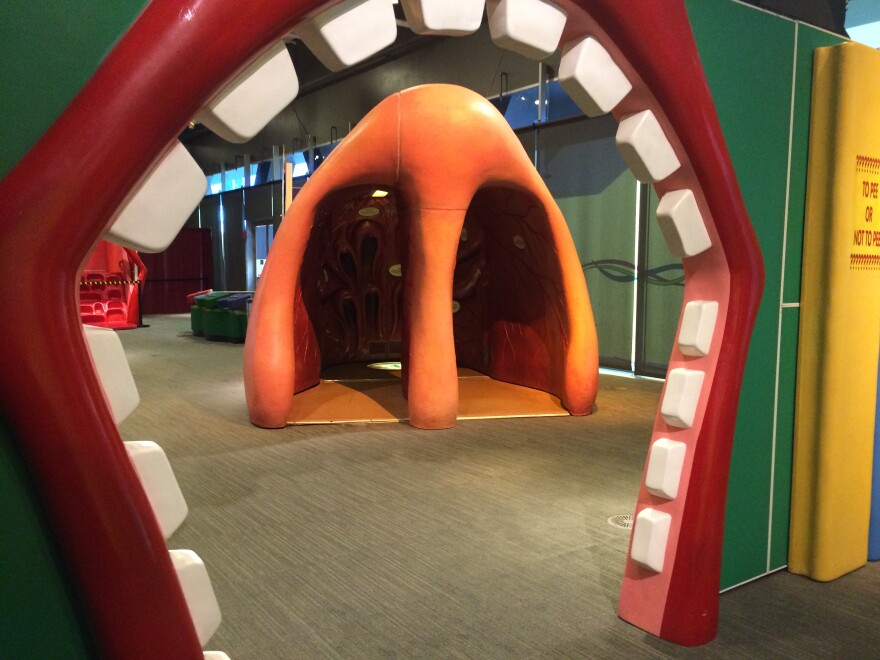Children learn more words in their first year of a science class than [they] learn in the first year of a language class. And that's why they hate science.
— Sylvia Branzei
At Grossology, a new exhibit at the Connecticut Science Center, one of the first things you see is a nine- or ten-foot-tall model of a human nose with six- or seven-foot-tall nostrils. As you enter, you're surrounded by things like the olfactory epithelium and the conchae, and you learn things like how the Eustachiantubes regulate the pressure around your ear drums and so then a stuffy nose makes your ears feel clogged.
As you stand there in this giant schnozz—learning more about how your tear ducts drain excess tears through your nose and so then your nose runs when you cry—the mucosa you’re standing on gets irritated, and the nose eventually sneezes you out with a blast of air from all directions.

Those large-enough-to-walk-through nostrils are one of the tamer stations in the exhibit. There’s a climbing wall made of zits, blisters, and scabs. There’s an entire display devoted to different ways the human body stinks. There’s a pinball game called Gas Attack! and a video game about urine. There’s a station about vomiting.
Grossology is all about all the grossest parts of our bodies and all the grossest things our bodies do. But, according to Sylvia Branzei, author of the series of books that the exhibit is based on, Grossology “isn’t about being gross. It’s [about] using Grossology as a hook to teach science and health science.”
“Actually,” she says, “I had an epiphany one day when I was clipping my toenails. I started thinking, ‘Eww, what’s that gunk underneath my toenails?’ And then I thought, ‘Oh, I can figure that out.’ I was a microbiology major. ‘Bang! Gross stuff! Kids like gross stuff! I want to teach some science. I’ll just invent a new science, and I’ll call it ‘grossology.’ ’ ”
And according to Hank Gruner, vice president of programs at the Science Center, their view is “This is an opportunity to expose your children to something in a fun way, and a creative, playful way that can invite some interesting conversations. Because everybody’s familiar with this and all of the words around it—the farting and everything, the terms that people use and snicker about. There’s science behind all that, and that’s a hook to engage folks.”

One of the first things you’ll notice about the Grossology exhibit is the language it uses. As much as I’ve already used words like ‘olfactory epithelium’ and ‘Eustachian tubes’ here, Grossology mostly uses pointedly plainer language.
According to Branzei, who was a science teacher before she started writing science books, “Children learn more words in their first year of a science class than you learn in the first year of a language class. And in science what happens is, they learn all these words, and then we make them apply [them] right away.?”
If you read some seventh- and eighth-grade science curricula for some towns in Connecticut (PDF links), you’ll find lots of words like ‘esophagus’ and ‘pancreas’ and ‘trachea’ and ‘bronchi.’ And, at least on paper, instead of talking about poop and farts and snot and sneezes, middle school classes discuss “breaking down food” and “eliminating waste” and the “exchange of gases between the body and its surroundings.”
“And that’s why [kids] hate science,” Branzei says. “Because it makes it hard, it makes it difficult. What I chose to do in my teaching, and later in my writing, was use normal, everyday terms that we use, teach all of the concepts so they can understand the concepts, and then put in the scientific words as well so that they become familiar with them, but they don’t become bogged down in the vocabulary and then lose the science because of it.”
Grossology’s Burps and Belches display does teach about eructation and the lower esophageal sphincter, but it's also got a burp machine where kids can mix soda and air and stomach acids to concoct a good, sizable belch.

Gruner says one way to better understand how our bodies work—even the noisy, stinky, crusty, slimy parts of our bodies—is just to talk about them. “If you go through and watch families, it’s very interesting. You will see them having the conversations. You will see them going through and talking about things. Yeah, you’ll see the snickering and things like that, but you’ll see meaningful conversations.”
“Because after all,” he says, “it is us.”
Grossology runs at the Connecticut Science Center in Hartford through March 8.
Lori Mack contributed to this story.








